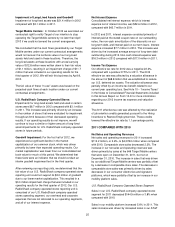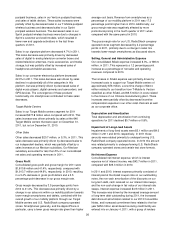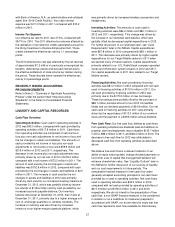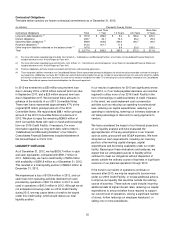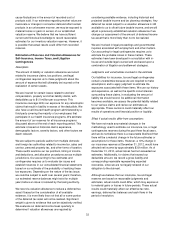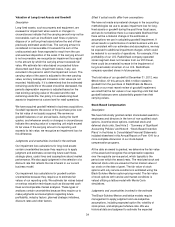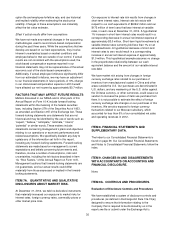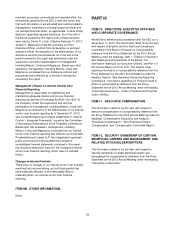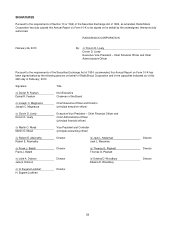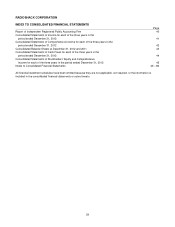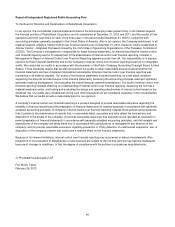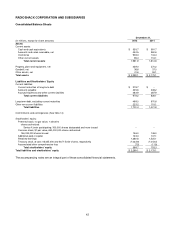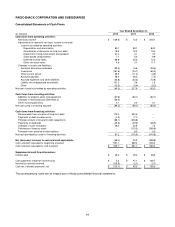Radio Shack 2012 Annual Report Download - page 36
Download and view the complete annual report
Please find page 36 of the 2012 Radio Shack annual report below. You can navigate through the pages in the report by either clicking on the pages listed below, or by using the keyword search tool below to find specific information within the annual report.34
Valuation of Long-Lived Assets and Goodwill
Description
Long-lived assets, such as property and equipment, are
reviewed for impairment when events or changes in
circumstances indicate that the carrying amount may not be
recoverable, such as insufficient cash flows or plans to
dispose of or sell long-lived assets before the end of their
previously estimated useful lives. The carrying amount is
considered not recoverable if it exceeds the sum of the
undiscounted cash flows expected to result from the use
and eventual disposition of the asset. If the carrying amount
is not recoverable, we recognize an impairment loss equal
to the amount by which the carrying amount exceeds fair
value. We estimate fair value based on projected future
discounted cash flows. Impairment losses, if any, are
recorded in the period in which the impairment occurs. The
carrying value of the asset is adjusted to the new carrying
value, and any subsequent increases in fair value are not
recorded. Additionally, if it is determined that the estimated
remaining useful life of the asset should be decreased, the
periodic depreciation expense is adjusted based on the
new existing carrying value of the asset and the new
remaining useful life. Our policy is to evaluate long-lived
assets for impairment at a store level for retail operations.
We have acquired goodwill related to business acquisitions.
Goodwill represents the excess of the purchase price over
the fair value of net assets acquired. We review our
goodwill balances on an annual basis, during the fourth
quarter, and whenever events or changes in circumstances
indicate the carrying value of a reporting unit might exceed
its fair value. If the carrying amount of a reporting unit
exceeds its fair value, we recognize an impairment loss for
this difference.
Judgments and uncertainties involved in the estimate
Our impairment loss calculations for long-lived assets
contain uncertainties because they require us to apply
judgment and estimates concerning future cash flows,
strategic plans, useful lives and assumptions about market
performance. We also apply judgment in the selection of a
discount rate that reflects the risk inherent in our current
business model.
Our impairment loss calculations for goodwill contain
uncertainties because they require us to estimate fair
values of our reporting units. We estimate fair values based
on various valuation techniques such as discounted cash
flows and comparable market analyses. These types of
analyses contain uncertainties because they require us to
make judgments and assumptions regarding future
profitability, industry factors, planned strategic initiatives,
discount rates and other factors.
Effect if actual results differ from assumptions
We have not made any material changes in the accounting
methodologies we use to assess impairment loss for long-
lived assets or goodwill during the past three fiscal years,
and we do not believe there is a reasonable likelihood that
there will be a material change in the estimates or
assumptions we use in calculating goodwill impairment. If
actual results or performance of certain business units are
not consistent with our estimates and assumptions, we may
be exposed to additional impairment charges, which could
be material to our results of operations. For example, if the
profitability of our U.S. RadioShack company-operated
stores segment does not increase from our 2012 level,
there could be a material increase in the impairment of
long-lived assets at certain of our U.S. RadioShack
company-operated stores in future periods.
The total value of our goodwill at December 31, 2012, was
$36.6 million. Of this amount, $36.1 million related to
goodwill from the purchase of RadioShack de Mexico.
Based on our most recent review of goodwill impairment,
we noted that the fair values of our reporting units that had
goodwill balances were substantially greater than their
carrying values.
Stock-Based Compensation
Description
We have historically granted certain stock-based awards to
employees and directors in the form of non-qualified stock
options, incentive stock options, restricted stock and
deferred stock units. See Note 2 - “Summary of Significant
Accounting Policies” and Note 8 - “Stock-Based Incentive
Plans” in the Notes to Consolidated Financial Statements
included elsewhere in this Annual Report on Form 10-K for a
more complete discussion of our stock-based
compensation programs.
At the date an award is granted, we determine the fair value
of the award and recognize the compensation expense
over the requisite service period, which typically is the
period over which the award vests. The restricted stock and
deferred stock units are valued at the fair market value of
our stock on the date of grant. The fair value of stock
options with only service conditions is estimated using the
Black-Scholes-Merton option-pricing model. The fair value
of stock options with service and market conditions is
valued utilizing a lattice model with Monte Carlo
simulations.
Judgments and uncertainties involved in the estimate
The Black-Scholes-Merton and lattice models require
management to apply judgment and use subjective
assumptions, including expected option life, volatility of
stock prices, and employee forfeiture rate. We use
historical data and judgment to estimate the expected



